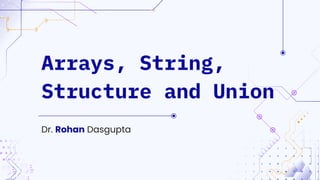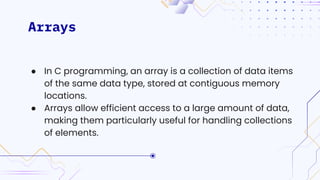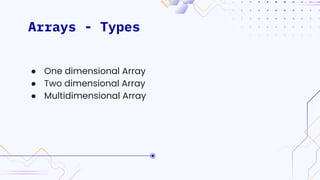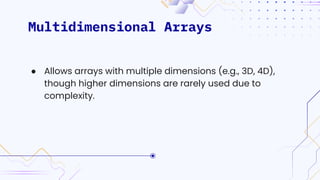C Programming Lab - Session 7 - Arrays, String, Structure and Union.pdf
- 1. Dr. Rohan Dasgupta Arrays, String, Structure and Union
- 2. Arrays ● In C programming, an array is a collection of data items of the same data type, stored at contiguous memory locations. ● Arrays allow efficient access to a large amount of data, making them particularly useful for handling collections of elements.
- 3. Arrays - Syntax ● data_type array_name[size]; ● Eg. int numbers[5]; ● Here, int is the data type, numbers is the array name, and 5 is the size of the array, indicating that it can store 5 integer elements.
- 4. Arrays - Types ● One dimensional Array ● Two dimensional Array ● Multidimensional Array
- 5. One Dimensional Arrays ● Stores data in a single row or line. int arr[5] = {1, 2, 3, 4, 5};
- 6. Two Dimensional Arrays ● Often used to represent matrices or tables. int matrix[3][3] = { {1, 2, 3}, {4, 5, 6}, {7, 8, 9} };
- 7. Multidimensional Arrays ● Allows arrays with multiple dimensions (e.g., 3D, 4D), though higher dimensions are rarely used due to complexity.
- 8. Arrays - Key Points ● Array indices start at 0. ● Array elements can be accessed by their index, e.g., array_name[index]. ● Arrays are fixed in size once declared.
- 9. Strings ● In C, a string is essentially an array of characters terminated by a null character ('0'). ● The null character at the end indicates the end of the string.
- 10. Strings - Syntax ● char string_name[size]; ● Example: char name[10] = "Hello"; ● Alternatively, you can initialize strings as follows: char name[] = "Hello"; ● This creates a character array where each character in "Hello" is stored in consecutive locations, followed by a '0' at the end.
- 11. Strings - Key Functions for Manipulation ● strlen(str): Returns the length of the string (excluding the null character). ● strcpy(dest, src): Copies the content of src into dest. ● strcat(dest, src): Appends src at the end of dest. ● strcmp(str1, str2): Compares two strings
- 12. Structures ● A structure in C is a user-defined data type that groups different data types together under a single name. ● It is particularly useful for representing complex data.
- 13. Structures - Syntax struct structure_name { data_type1 member1; data_type2 member2; ... };
- 14. Structures - Example struct Student { int id; char name[50]; float grade; }; In this example, Student is a structure that has three members: id (integer), name (character array), and grade (float).
- 15. Structures - Key Points Defining Structure Variables - You can define variables of a structure type using: struct Student student1; Accessing Members - Use the dot operator (.) to access structure members: student1.id = 101; student1.grade = 85.5; Nested Structures: Structures can contain other structures as members, which is useful for more complex data representations.
- 16. Union A union is similar to a structure, but it only allocates memory for the largest member, and all members share this memory space. It is useful when you need a single variable to hold different types of data at different times.
- 17. Union - Syntax union union_name { data_type1 member1; data_type2 member2; ... };
- 18. Union - Example union Data { int i; float f; char str[20]; };
- 19. Union - Key Points ● Only one member can hold a value at a time. If you assign a value to one member, the previous value stored in any other member is overwritten. ● Accessing Union Members: Similar to structures, you use the dot operator. union Data data; data.i = 10; // Sets the integer value data.f = 220.5; // Now `i` is overwritten, and `f` holds a float value
- 20. Structure vs. Union ● Memory Usage: In a structure, each member has its own memory, whereas in a union, all members share the same memory. ● Usage Scenario: Use structures when you need multiple data types together. Use unions when you want to store one of many data types at a time in the same memory location.
- 21. Write short notes on 1. Array 2. String 3. Structure 4. Union Rubrics: 1. Timely submission: 3 marks (next week), 2 marks (week after) 2. Correct answers: 1.5 marks per question 3. Neatness: 1 mark Assignment No. 2 Array, String, Structure & Union
- 22. Thank you. Dr. Rohan Dasgupta



![Arrays - Syntax
● data_type array_name[size];
● Eg. int numbers[5];
● Here, int is the data type, numbers is the array name,
and 5 is the size of the array, indicating that it can store
5 integer elements.](https://image.slidesharecdn.com/arraysstringstructureandunion-241110180616-e4c35912/85/C-Programming-Lab-Session-7-Arrays-String-Structure-and-Union-pdf-3-320.jpg)

![One Dimensional Arrays
● Stores data in a single row or line.
int arr[5] = {1, 2, 3, 4, 5};](https://image.slidesharecdn.com/arraysstringstructureandunion-241110180616-e4c35912/85/C-Programming-Lab-Session-7-Arrays-String-Structure-and-Union-pdf-5-320.jpg)
![Two Dimensional Arrays
● Often used to represent matrices or tables.
int matrix[3][3] = {
{1, 2, 3},
{4, 5, 6},
{7, 8, 9}
};](https://image.slidesharecdn.com/arraysstringstructureandunion-241110180616-e4c35912/85/C-Programming-Lab-Session-7-Arrays-String-Structure-and-Union-pdf-6-320.jpg)

![Arrays - Key Points
● Array indices start at 0.
● Array elements can be accessed by their index, e.g.,
array_name[index].
● Arrays are fixed in size once declared.](https://image.slidesharecdn.com/arraysstringstructureandunion-241110180616-e4c35912/85/C-Programming-Lab-Session-7-Arrays-String-Structure-and-Union-pdf-8-320.jpg)

![Strings - Syntax
● char string_name[size];
● Example: char name[10] = "Hello";
● Alternatively, you can initialize strings as follows:
char name[] = "Hello";
● This creates a character array where each character in
"Hello" is stored in consecutive locations, followed by a
'0' at the end.](https://image.slidesharecdn.com/arraysstringstructureandunion-241110180616-e4c35912/85/C-Programming-Lab-Session-7-Arrays-String-Structure-and-Union-pdf-10-320.jpg)



![Structures - Example
struct Student {
int id;
char name[50];
float grade;
};
In this example, Student is a structure that has three members:
id (integer), name (character array), and grade (float).](https://image.slidesharecdn.com/arraysstringstructureandunion-241110180616-e4c35912/85/C-Programming-Lab-Session-7-Arrays-String-Structure-and-Union-pdf-14-320.jpg)



![Union - Example
union Data {
int i;
float f;
char str[20];
};](https://image.slidesharecdn.com/arraysstringstructureandunion-241110180616-e4c35912/85/C-Programming-Lab-Session-7-Arrays-String-Structure-and-Union-pdf-18-320.jpg)




